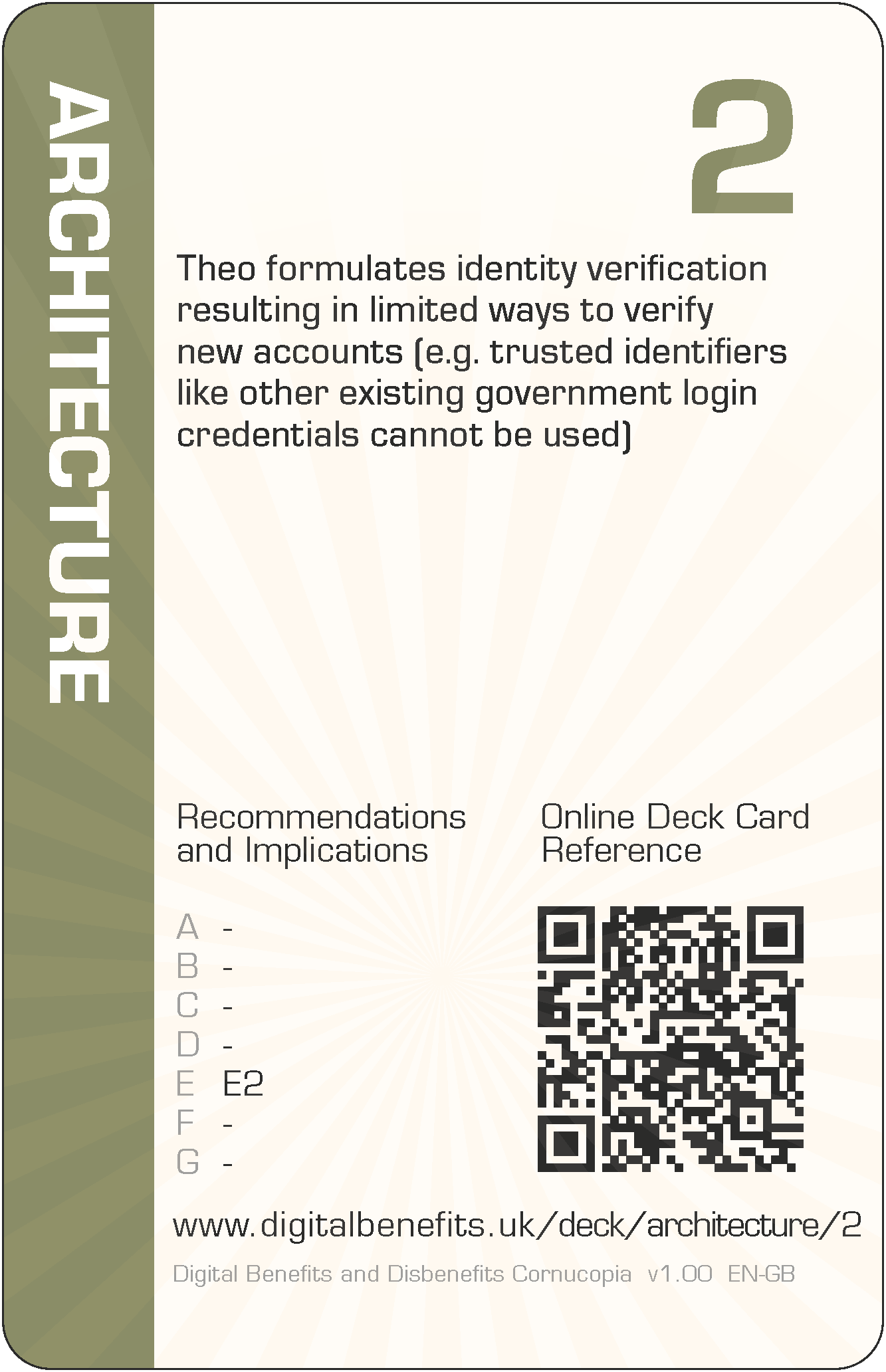Architecture 2 (AR-2) Card
DBD Cornucopia > Deck > Architecture > 2
Card Details - Two of Architecture
Abbreviation
AR-2
Card's focus
The focus of this card is identity and its verification
Threat to claimants
Theo formulates identity verification resulting in limited ways to verify new accounts (e.g. trusted identifiers like other existing government login credentials cannot be used)

Threat to claimants
Theo formulates identity verification resulting in limited ways to verify new accounts (e.g. trusted identifiers like other existing government login credentials cannot be used).
Some examples of how this threat could lead to harms (negative effects on claimants)
The design recommendations and implications relevant to the card are listed below in the next section, but even those can be somewhat abstract and difficult to think about during practical day-to-day implementation. Therefore, some example harms are provided to complement the more formal research outputs. These examples are unique per card, and are only published on these web pages (i.e. in no other project outputs).
- Instead of permanent personal identifiers, claimant IDs are email addresses, which claimants lose access to or change relatively often, leading to difficulties logging on and a high level of account resets and repeat of costly identity verification (e.g. award delay, clerical effort, time loss for travel to meeting, monetary cost of obtaining evidence and travel)
- Claimants cannot use their Government Gateway IDs and have to create and remember new identifiers and authentication credentials to use the service
- Identity verification relies on claimants keeping, finding and showing other paperwork in face-to-face meetings which could be far away from where they live or work
The examples are to help understand the threat on the card, not to suppress thinking and innovation. Incorporating these examples exactly, or closely matching ones, should be scored down when playing DBD Cornucopia as a game.
Applicable design recommendations and implications
These are reproduced here from Research Briefing N
Design systems which support the division of labour with claimants' ecosystems
- Expand claimant autonomy, control and choice, backed up by transparency of actions and activities
Enable claimants to better engage with digital welfare and empower them to make their own choices and decisions. Attribute information sources, other advice and decisions; build in logging and audit trail generation; provide access to records of what information was used to make choices/decisions and by whom; provide mechanisms for claimants to question, discuss and challenge actions, provide feedback, and make complaints.
General Notes
Card values (i.e. '2' for this card) are for game play and are not correlated with the severity of harm. This is because threats cannot be ranked directly since they can affect individuals in different ways due to situations and circumstances, or affect fewer or more claimants, or the harms can arise in claimants' support networks and wider society.
The threat description uses a person's name as the "attacker" (i.e. 'Theo' for this card), which can be thought of someone involved with implementation. They could have any role which influence digitisation. So they could be a database administrator, or a copy writer, or a quality assurance specialist, etc, or all of these. Everyone could have some influence on the claimant threat described. The names were randomly selected from those currently most popular as given names for boys and girls (UK Office for National Statistics).
The example harms provided are drawn from the research data (which explored not only parts of existing services but also the effects of possible changes to those), from the author's own knowledge of web application development and testing, the author's own experience of helping citizens to claim Universal Credit (UC) and Personal Independence Payment (PIP), and from suggestions submitted by other people (make a suggestion). The threats and example harms do not necessarily exist in the current UC or PIP deployments or in ecosystems around those services, but they might well do.
All the cards in this Architecture suit are: 2 3 4 5 6 7 8 9 10 J Q K A
The other suits in the deck are: Scope, Agency, Trust, Porosity and Cornucopia (plus Jokers).
